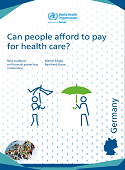Can people afford to pay for health care? New evidence on financial protection in Germany (2018)

Download
ISBN 978 92 890 5324 2
xii + 76 pages
This publication is only available online.
This review is part of a series of country-based studies generating new evidence on financial protection in European health systems. Financial protection is central to universal health coverage and a core dimension of health system performance.
The incidence of catastrophic health spending is quite low in Germany compared to many countries in Europe. This reflects high levels of public spending on health, and health coverage policy carefully designed to protect children and regular users of health care from co-payments.
Catastrophic spending on health is concentrated among older people and people in households whose main source of income is social benefits. The drivers of financial hardship are dental care on average, and both dental care and outpatient medicines among the poorest households.
The introduction of an income-related cap on co-payments in 2004 and the abolition of co-payments for outpatient visits in 2012 have been important protective measures. The results of this analysis suggest that more could be done to protect poor households, however, and to reduce the financial hardship associated with dental care. Options include exempting low-income households from co-payments and making the cap less bureaucratic.



